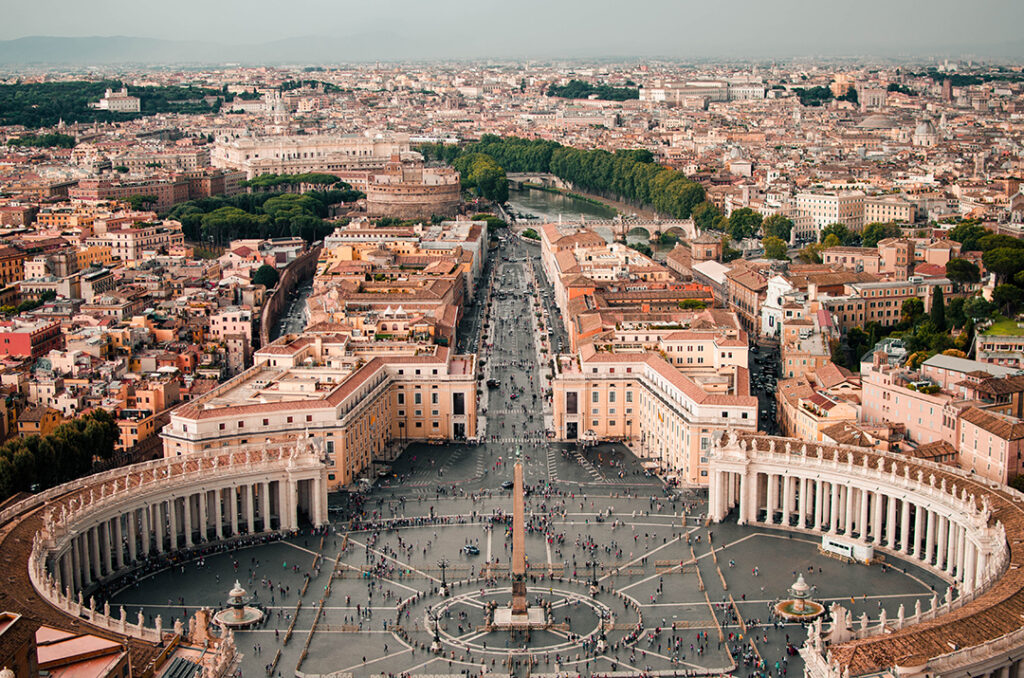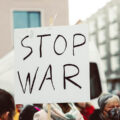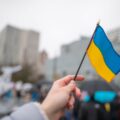The pope and war: The Vatican’s peace politics
The pope and war: The Vatican’s peace politics
With wars raging around the world, Christians and non-Christians often look to the pope for guidance. But does the Vatican’s historical relationship to war inspire confidence?
Saint Peter, known by Roman Catholics as the first pope, used to carry a sword. John’s Gospel records that, when Jesus was threatened with arrest, Peter “drew his sword and struck the high priest’s servant, cutting off his right ear.”[1]
For as long as the Roman Catholic Church has existed, the Vatican has been unable to avoid the reality of war. In many cases, its stance has been one of pacifism – the belief that disputes should be settled by peaceful means. After all, Jesus commanded Peter to put his sword away,[2] and healed the servant’s wound.[3]
However, its teachings allow that war is justifiable in some cases.[4] The Vatican has also started its own military campaigns. So what is the Vatican’s stance on war and peace, and how does it influence the politics of war today?
Involvement in Russia-Ukraine
Pope Francis has consistently condemned the ongoing war in Ukraine, calling it “absurd and cruel.”[5] [6] The 265th pope since Saint Peter has preferred to remain neutral, though appearing to make occasional gestures of solidarity with both Ukraine and Russia.[7] [8] This has drawn much criticism from both sides.[9] [10]
However, Pope Francis’ refusal to take sides is likely a strategic move. It reflects a changing church whose members are increasingly non-Western, and whose sympathies may not immediately lie with Ukraine.[11] As the first Latin American pope, Francis shows signs of deep ambivalence towards the United States and the West, given its history of interference there.[12]
His neutrality is surely also intended to promote the cause of peace while not alienating himself as a global spiritual figurehead. The Vatican recently confirmed a senior clerical figure would head a peace mission to the conflict zone,[13] which Russia appeared to welcome.[14]
Teachings behind the Vatican’s peace politics
Russia’s war in Ukraine has brought the Catholic Church’s teaching on war and ‘just war’ into the spotlight.[15] Unlike some Christian denominations such as the Quakers, the Catholic Church is not pacifist in principle.
The Catechism of the Catholic Church outlines the criteria by which a war can be engaged in and conducted justly. Briefly, a state or community is justified in going to war if:
- An aggressor is causing serious and lasting damage
- All other solutions have been exhausted
- War has a good chance of succeeding, and
- The war must cause less destruction than it saves.[16]
War must only be defensive, never aggressive, and must serve the common good.[17] In 2020, Pope Francis warned that advanced technologies of war make war even more important to avoid. He also cautioned against using biased or outdated reasoning to justify a war that benefits only some people.[18] “We can no longer think of war as a solution.”[19]
Pope Francis: diplomat
Pope Francis has oriented many of his international trips around diplomatic opportunities. His risky trip to Iraq in 2021, including wartorn conflict zones, is best understood as a statement in support of peace, rather than political manoeuvring.[20]
While visiting the Democratic Republic of Congo and South Sudan, Pope Francis sought out firsthand accounts of the horrors of war.[21] [22] His focus on the innocent victims of war coheres with his wider programmes towards social justice, such as in his encyclical Fratelli Tutti.[23]
‘Chaplain of NATO’
Many have interpreted the Vatican as practising ‘great-power diplomacy’ through much of history. This strategy involved aligning itself with the superpower of the time, and was no more evident than in the 20th century.[24]
During the Cold War, John Paul II rose to be one of the most important leaders in the fight against Soviet Communism. While the vocabulary used was largely theological, the Vatican positioned itself diplomatically, allying itself to (what it saw as) the West’s struggle for freedom against the Soviet threat.[25]
Pius XII, pope during the Second World War, was also a ferocious anti-Communist, so much so that he was dubbed “the chaplain of NATO” (North Atlantic Treaty Alliance, set up in the wake of WWII).[26] This same strategy of being allied with the strongest power is also evident in the Vatican’s support of the Holy Roman Empire, the French monarchy, and the Austro-Hungarian empire.[27]
Second World War – divided loyalties
However, the same pope (Pius XII) has long been criticised for not doing more to condemn the atrocities of WWII, or even sympathising with the Nazis.[28] His recently opened archives shed light on the Vatican’s relative silence in the face of the greatest evil of the 20th century.[29] [30]
The pope met with the Nazis and agreed to stay out of “partisan politics” in the Third Reich. He said nothing during the Nazi’s round-up of Rome’s Jews, despite extensive knowledge of the atrocities occurring.[31] Other research, however, shows that the Catholic Church was instrumental in saving 860,000 Jews from Nazi death camps.[32]
It also emerged that Pope Pius XII had a “secret back channel to Hitler”, and negotiated with him for the sake of Catholics in Nazi-controlled territory among other things.[33] While it may be seen as countenancing evil, the pope’s willingness to negotiate may be seen as a diplomatic effort to promote peace.[34] [35]
The Vatican remained officially neutral throughout the war, and was criticised by both sides as supporting the other.[36] WWII demonstrates how difficult the Vatican’s role as diplomatic state, spiritual leader, and shepherd of souls can be.[37]
The Crusades
The Vatican has not always advocated for peace, however. This is nowhere more evident than in the phenomenon of the Crusades. These military pilgrimages from western Europe eastwards were understood as justified, even saintly, wars against infidel Muslims and other heretical groups.[38]
For more than 200 years from 1095, Roman Catholic popes either initiated, supported, or directed these religious wars.[39] The movements gained widespread support across all parts of society.[40] Christian warriors who died in battle were understood as saints and martyrs, their remains became relics.[41]
The pope and war
We have seen that the common understanding of the Vatican as an absolute advocate for peace needs reconsidering. Recent popes have demonstrated that, while peace may be the Church’s ultimate goal, it will support war under certain circumstances.
As the head of a state and a global movement, the pope will always need to negotiate their commitments to diplomacy, believers, media, and God. Two millennia on, Saint Peter’s heir must still choose whether to draw his sword.
Want to learn more about similar topics? Go to the EARS Dashboard
Sources
[1] John 18:10
[2] John 18:11
[3] Luke 22:51
[4] Revisiting the Catholic Church’s Just War Doctrine Through the Lens of the Russia-Ukraine Conflict
[5] Pope Francis appeals for end to “absurd and cruel” Ukraine war
[6] One year of war in Ukraine: Pope Francis’ sorrow and tireless appeals for peace
[7] Pope Francis has failed to be a spiritual mediator in Ukraine
[8] Vatican Seeks to Clarify Pope’s Stance on Ukraine
[9] Why Pope Francis Isn’t With the West on Ukraine
[10] Pope Francis has failed to be a spiritual mediator in Ukraine
[11] Why Pope Francis Isn’t With the West on Ukraine
[12] Why Pope Francis Isn’t With the West on Ukraine
[13] Pope’s Ukraine peace envoy blasts war as a ‘pandemic’ that affects everyone
[14] Russia acknowledges Vatican peace initiative, says no steps yet for a mission to Moscow
[15] Revisiting the Catholic Church’s Just War Doctrine Through the Lens of the Russia-Ukraine Conflict
[17] Catholic Conscience: Just war
[18] Fratelli Tutti, no. 258.
[19] Fratelli Tutti, no. 258.
[20] Why Pope Francis’s historic trip to Iraq was a mission of peace over politics
[21] Pope Francis to meet war victims on South Sudan peace pilgrimage
[22] Pope hears harrowing tales of Congo violence and says: ‘Enough!’
[23] “Fratelli tutti”: long summary of Pope Francis’s Social Encyclical
[24] Why Pope Francis Isn’t With the West on Ukraine
[25] How Saint John Paul II Conquered Communism
[26] Reactions to Ukraine show the era of Pope as NATO chaplain is over
[27] Why Pope Francis Isn’t With the West on Ukraine
[28] Unsealing of Vatican archives will finally reveal truth about ‘Hitler’s pope’
[29] Unsealing of Vatican archives will finally reveal truth about ‘Hitler’s pope’
[30] David Kertzer, The Pope at War: The Secret History of Pius XII, Mussolini, and Hitler (Random House, 2022).
[31] The pope who thought he could negotiate with Hitler
[32] Pope Pius XII and the Holocaust
[33] The pope’s secret back channel to Hitler
[34] Margherita Marchione, Pope Pius XII: Architect for Peace (Paulist Press, 2000).
[35] John Pollard, ‘Pius XII: Peace Diplomacy and War’ in John Pollard, The Papacy in the Age of Totalitarianism, 1914-1958 (Oxford Academic, 2014), pp.291-325.
[37] John Pollard, ‘Pius XII: Peace Diplomacy and War’ in John Pollard, The Papacy in the Age of Totalitarianism, 1914-1958 (Oxford Academic, 2014), pp.291-325.
[40] Conor Kostick, The Social Structure of the First Crusade (Brill, 2008).






